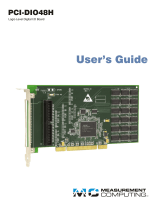Page is loading ...

DS SSR-RACK48.doc
Document Revision 1.1, March, 2010 Copyright © Measurement Computing Corporation
SSR-RACK48
48 Channel Solid State Relay (OPTO22, Gordos) Mounting & Interface Rack
Description
The SSR-RACK48 is a high-density mounting and interface
rack for use with quad-type solid-state relays. The SSR-
RACK48 is the perfect means of interfacing quad solid
state relays (SSR) modules to any 48, 96, or 192-line digital
I/O board with 50-pin connectors
SSR-RACK48 provides positions for 12 quad relays, and
has screw terminals for each module. The screw terminals
allow you to connect signals via 12-22 AWG wire. Signals
are routed through the SSRs to the 50-pin, 48-line
connector.
The SSR-RACK48 is 100% connector-compatible with the
following Measurement Computing Corporation (MCC)
boards:
PCI-DIO48H
CIO-DI48
PCI-DIO48H-RT
CIO-DI96
PCI-DIO96H
CIO-DI192
CIO-DIO48
CIO-DO48
CIO-DIO96
CIO-DO96
CIO-DIO192
CIO-DO192
By using any of these products with the SSR-RACK48, you
can construct a digital control system with the highest
possible density.

SSR-RACK48 Datasheet
DS SSR-RACK48.doc
Document Revision 1.1, March, 2010 Copyright © Measurement Computing Corporation
SSR-RACK has on-board buffers
Because most manufacturers of SSR racks do not supply
output buffers on the SSR rack, simple digital I/O boards
such as the CIO-DIO24, 48, and 96, and other
manufacturer's 82C55-based digital I/O boards do not have
the power to switch the SSRs. For example, to use an
OPTO22 PB16 rack, you need to use a high-drive DIO
board such as the CIO-DIO24H or CIO-DUAL-AC5.
In order to be usable with all common TTL output boards,
the SSR-RACK48 is designed with buffers on board. With
these buffers, you can plug directly into the SSR-RACK48
from your CIO-DIO 48, 96 or 192 or any other
manufacturer's 82C55-based digital I/O board.
Choosing solid state relays
AC or DC, input (sense) or output (switch)
An SSR module performs one of the following functions:
AC input
AC output
DC input
DC output
The SSR senses (input) and switches (output) AC and DC
voltages.
4,000 volt AC isolation
The high voltage AC or DC signal never reaches the DIO
board. Instead, the signal is converted to TTL by the SSR
(input) or switched by the SSR (output). The DIO board
and the PC are protected from up to 4,000 volts (V) AC on
the SSR's inputs by the optical isolation circuit in the SSR.
Detect and control voltage and current loads that
exceed the capability of TTL
SSR modules can switch loads up to 3.5 A at rated voltages
of 280 VAC and 200 VDC (1 A max). A single SSR can
start small motors, switch large capacity motor-starter
relays, electric appliances, sprinkler valves, alarms, and
annunciator beacons.
Quad relays required
SSRs are available as a single-relay circuit in a plastic case,
or as four identical relay circuits in a plastic case. The SSR-
RACK48 requires quad relays. MCC's SSR-4 series of quad
I/O modules are compatible with the SSR-RACK48.
Because of the savings in racks, cables, and cabinet space,
quad relays are the economic alternative to single-function
relays.
Quads have shared commons
Quad relays are constructed with a shared common between
each pair of two SSR circuits. This may be important,
depending on the relay-to-relay isolation required by your
application.
SSR-RACK inverting logic
On an input SSR, the presence of a voltage raises the TTL
output of the SSR from TTL low to TTL high. Because the
SSR-RACK uses the conventional inverting logic, the
completed circuit of SSR and SSR-RACK lowers the signal
to the DIO board from TTL high (+5) to TTL low (GND).
An output SSR completes a circuit when the DIO board
TTL signal to the SSR is low. The circuit through the SSR
is open when the signal from the DIO board is high.
Converting the SSR-RACK from inverting logic
The SSR-RACK follows the convention set by OPTO22
and followed by virtually all SSR rack manufacturers — the
sense and control logic for the relays is inverted. This
means that a 0 output from the digital I/O board causes an
output relay to activate (complete the circuit), while a 1
(TTL high) causes the relay to deactivate. The chips which
invert the logic are socketed and can be easily replaced with
chips that do not invert the logic. Discuss your order with a
technical sales engineer if you need non-inverting logic.

SSR-RACK48 Datasheet
DS SSR-RACK48.doc
Document Revision 1.1, March, 2010 Copyright © Measurement Computing Corporation
I/O connector pin out
Pin map
Refer to the following pin mapping table if your digital
board is not a Measurement Computing board.
Signal name
Pin
FIRSTPORTA Bit 0
Module 1
FIRSTPORTA Bit 1
Module 2
FIRSTPORTA Bit 2
Module 3
FIRSTPORTA Bit 3
Module 4
FIRSTPORTA Bit 4
Module 5
FIRSTPORTA Bit 5
Module 6
FIRSTPORTA Bit 6
Module 7
FIRSTPORTA Bit 7
Module 8
FIRSTPORTB Bit 0
Module 9
FIRSTPORTB Bit 1
Module 10
FIRSTPORTB Bit 2
Module 11
FIRSTPORTB Bit 3
Module 12
FIRSTPORTB Bit 4
Module 13
FIRSTPORTB Bit 5
Module 14
FIRSTPORTB Bit 6
Module 15
FIRSTPORTB Bit 7
Module 16
FIRSTPORTC Bit 0
Module 17
FIRSTPORTC Bit 1
Module 18
FIRSTPORTC Bit 2
Module 19
FIRSTPORTC Bit 3
Module 20
FIRSTPORTC Bit 4
Module 21
FIRSTPORTC Bit 5
Module 22
FIRSTPORTC Bit 6
Module 23
FIRSTPORTC Bit 7
Module 24
SECONDPORTA Bit 0
Module 25
SECONDPORTA Bit 1
Module 26
SECONDPORTA Bit 2
Module 27
SECONDPORTA Bit 3
Module 28
SECONDPORTA Bit 4
Module 29
SECONDPORTA Bit 5
Module 30
SECONDPORTA Bit 6
Module 31
SECONDPORTA Bit 7
Module 32
SECONDPORTB Bit 0
Module 33
SECONDPORTB Bit 1
Module 34
SECONDPORTB Bit 2
Module 35
SECONDPORTB Bit 3
Module 36
SECONDPORTB Bit 4
Module 37
SECONDPORTB Bit 5
Module 38
SECONDPORTB Bit 6
Module 39
SECONDPORTB Bit 7
Module 40
SECONDPORTC Bit 0
Module 41
SECONDPORTC Bit 1
Module 42
SECONDPORTC Bit 2
Module 43
SECONDPORTC Bit 3
Module 44
SECONDPORTC Bit 4
Module 45
SECONDPORTC Bit 5
Module 46
SECONDPORTC Bit 6
Module 47
SECONDPORTC Bit 7
Module 48
/
